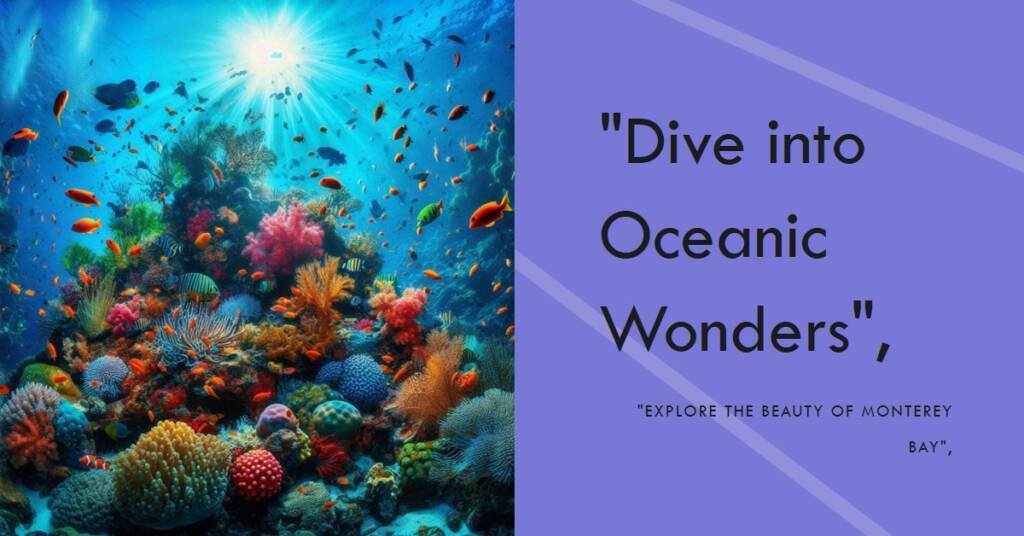
Table of Contents
Introduction to Monterey Bay Aquarium
The Monterey Bay Aquarium, located on Cannery Row in Monterey, California, is one of the most renowned aquariums in the world. Opened in 1984, it has become a vital institution for marine research, education, and conservation. Nestled along the beautiful Central Coast of California, the aquarium is positioned adjacent to the diverse marine environments of the Monterey Bay National Marine Sanctuary, which enriches its extensive programs and exhibits.
With a mission centered on inspiring ocean conservation, the Monterey Bay Aquarium plays a crucial role in raising awareness about marine ecosystems and the importance of protecting our oceans. The organization not only showcases a wide array of marine life but also emphasizes the interconnectedness of human activity and ocean health. Through its carefully curated exhibits, the aquarium aims to engage visitors of all ages, encouraging them to appreciate the beauty of oceanic wonders and to understand the critical challenges facing marine environments.
Throughout its history, the Monterey Bay Aquarium has been a leader in marine research and conservation efforts. Its reputation is bolstered by groundbreaking work in areas such as sustainable seafood practices, climate change awareness, and habitat preservation. The aquarium actively collaborates with various organizations and research institutions, demonstrating a commitment to employing science and education as tools for fostering a deeper understanding of the ocean’s complexities.
In essence, the Monterey Bay Aquarium stands as a beacon for those passionate about marine life and environmental stewardship. With its strategic location and dedication to conservation, it remains a significant contributor to the marine research community, inspiring countless individuals to take action in protecting oceanic ecosystems and ensuring their sustainability for future generations.
The Oceanic Wonders of Monterey Bay
The Monterey Bay Aquarium serves as a gateway to the striking biodiversity found in the waters of Monterey Bay. This extraordinary marine environment, characterized by its rich ecosystems, hosts a vibrant array of life forms that thrive in both shallow coastal regions and deeper oceanic waters. The cold, nutrient-rich currents of the California Current play a pivotal role in sustaining this biological abundance, making it an essential area for marine research and conservation.
One of the key features of the oceanic wonders in Monterey Bay is the diverse range of habitats it supports. From kelp forests to sandy beaches, these ecosystems are home to a multitude of species, each contributing to the intricate web of life. The kelp forest, in particular, provides shelter and food for various marine organisms, including the playful sea otters, which play a crucial role in maintaining the health of these underwater forests. By controlling the population of sea urchins, sea otters help prevent overgrazing of kelp, promoting a balanced ecosystem.
In addition to marine mammals like sea otters, the waters around Monterey Bay are teeming with fascinating creatures such as jellyfish, which exhibit mesmerizing movements and display a spectrum of colors. The aquarium showcases various jellyfish species, offering insight into their unique life cycles and adaptations. Furthermore, the diverse fish populations, including rockfish and sardines, display remarkable adaptations that allow them to thrive in this dynamic marine environment.
The Monterey Bay Aquarium not only emphasizes the importance of conserving these remarkable ecosystems but also fosters a deeper understanding of the oceanic wonders that reside within. Visitors are provided with a unique opportunity to explore and appreciate the complex relationships among marine species, exemplifying the critical nature of biodiversity in maintaining a healthy ocean.
Diving Experiences: What to Expect
The Monterey Bay Aquarium offers an unparalleled diving experience that allows enthusiasts to immerse themselves in the captivating underwater world. These diving programs not only cater to experienced divers but also welcome novices, making it a unique opportunity for everyone to explore the ocean’s depths. Participants must meet certain requirements, including possessing a valid scuba certification from a recognized agency for those who wish to engage in more advanced dives. Additionally, participants should be in good health and able to perform basic swimming skills to ensure a safe and enjoyable experience.
Safety is paramount in these programs, with the aquarium employing multiple measures to ensure that divers can explore the underwater environment worry-free. Prior to diving, participants undergo a comprehensive briefing that covers essential safety protocols, alongside a review of the equipment and techniques necessary for the dive. In-water guides accompany all diving expeditions, providing expert support and ensuring that divers are continually monitored throughout their adventure. This professional supervision helps to minimize risks and enhance the educational aspects of the experience.
Divers can expect to encounter a vibrant array of marine life, such as graceful rays, playful sea otters, and colorful schools of fish that are native to the Monterey Bay. The experience also allows for close interactions with various species, providing divers the chance to observe their behaviors and habitats firsthand. Additionally, the aquarium design integrates several specialized exhibits, ensuring that divers are immersed in an environment that showcases the health and diversity of ocean ecosystems. Whether you’re a passionate marine enthusiast or a casual adventurer, a diving experience at the Monterey Bay Aquarium promises to be a memorable journey into the depths of oceanic wonders.
Conservation Efforts and Research
The Monterey Bay Aquarium stands at the forefront of marine conservation, undertaking a range of initiatives aimed at preserving diverse ocean habitats and protecting endangered species. Its commitment to research and education serves as a model for aquariums worldwide, enhancing both public awareness and scientific understanding of marine ecosystems.
One notable conservation program is the aquarium’s involvement in the Ocean Health Index, which evaluates the overall health of ocean ecosystems based on various indicators. By collaborating with scientists and policymakers, the aquarium aims to provide actionable data that can guide better management of marine resources. Additionally, the aquarium is a leading participant in the Sea Otter Recovery Program, which focuses on restoring sea otter populations along California’s coast. This initiative not only protects the sea otters themselves but also contributes to the overall health of kelp forest ecosystems, illustrating the interconnectedness of marine life.
Research initiatives at the Monterey Bay Aquarium also address issues such as climate change and its impact on marine species. The aquarium’s Environmental Research Division has been pivotal in studying ocean acidity and its effects on marine organisms, particularly shellfish. These findings are crucial for informing policies on sustainable fishing and habitat protection. Furthermore, the aquarium collaborates with various organizations to promote coral reef conservation through the Coral Triangle Initiative, aiming to safeguard one of the richest coral reef ecosystems in the world.
Through these extensive conservation efforts and research programs, the Monterey Bay Aquarium plays a vital role in marine conservation. By engaging in scientific studies and actively participating in global and local conservation efforts, the aquarium not only protects marine environments but also educates the public on the importance of preserving the delicate balance of our oceanic ecosystems.
Educational Programs and Community Involvement
The Monterey Bay Aquarium is renowned not only for its awe-inspiring aquatic exhibits but also for its robust educational programs aimed at various age groups and communities. These programs serve to enlighten visitors about marine life, conservation, and the importance of protecting our oceans. The aquarium tailors its offerings to engage with diverse demographics, making marine education accessible to everyone.
One of the standout features of the aquarium’s educational endeavor is its workshops and guided tours. These hands-on experiences allow participants to engage directly with marine experts, creating interactive learning opportunities that are rich in content. Workshops are designed for all ages, from young children to adults, focusing on topics such as marine biology, ecology, and environmental stewardship. Guided tours enhance visitors’ experiences, providing insights into the aquarium’s exhibits while fostering a deeper connection to oceanic ecosystems.
The aquarium also plays a vital role in local education through its school programs. These programs offer tailored field trips and interactive curricula that align with state educational standards. By collaborating with local schools, the aquarium ensures that students gain meaningful experiences related to marine life. Programs are designed to inspire curiosity and promote hands-on learning; students often engage in scientific inquiry and exploration, thereby reinforcing classroom knowledge through real-world applications.
Furthermore, community outreach initiatives are fundamental to the Monterey Bay Aquarium’s mission. The aquarium actively participates in various outreach activities that target underrepresented communities, making marine education more inclusive. Through partnerships with local organizations, the aquarium extends its reach into the community, fostering a sense of shared responsibility for ocean conservation. Through these programs, the aquarium cultivates a community of informed and engaged citizens who appreciate the significance of marine ecosystems.
Unique Exhibits at the Aquarium
The Monterey Bay Aquarium is renowned for its diverse collection of aquatic life and innovative exhibits that captivate visitors of all ages. Among its most unique displays is the Kelp Forest, an immersive environment that showcases the beauty and complexity of a thriving underwater ecosystem. Rising to a height of 28 feet, this exhibit features various species of kelp, along with colorful inhabitants such as sea otters, moon jellyfish, and rockfish. The dynamic nature of this environment offers a glimpse into the significant role these species play in sustaining marine biodiversity.
Another standout feature of the aquarium is the Open Sea exhibit, which is designed to replicate the expansive ocean environment. This remarkable installation showcases a diverse array of marine life, including vibrant schools of fish, majestic sea turtles, and weighty sharks. Measuring over 90 feet long, the Open Sea exhibit utilizes cutting-edge technology to create a realistic simulation of ocean currents and habitats. Visitors can observe the behaviors and interactions of these marine creatures in a way that is both educational and visually stunning.
The Touch Pools exhibit invites guests to engage with marine life directly, underscoring the aquarium’s commitment to interactive learning. This hands-on experience allows visitors to gently touch and explore tide pool creatures such as sea stars and anemones. Educators are available to provide insight into the natural history and conservation of these organisms, fostering a deeper understanding of ocean ecology. By encouraging personal interaction with marine ecosystems, the Touch Pools exhibit plays an essential role in promoting ocean conservation and awareness.
Overall, the Monterey Bay Aquarium’s unique exhibits highlight the wonder and importance of oceanic ecosystems. Each display offers a different aspect of marine life, contributing to a comprehensive understanding of the ocean and stressing the importance of its conservation.
Visitor Information: Planning Your Trip
When planning a visit to the Monterey Bay Aquarium, it is essential to be informed about various aspects to ensure a smooth experience. The aquarium typically operates from 10 a.m. to 5 p.m., with extended hours during the summer months. However, it is advisable to check the official website for current hours and any special events that may affect daily operations.
Tickets can be purchased online, which is highly recommended to avoid long wait times, especially during weekends and holidays. Standard admission ticket prices vary based on age, with discounts available for seniors and children. Additionally, the aquarium offers various membership options, which provide unlimited visits throughout the year along with other perks such as discounts at the gift shop and exclusive member events.
Accessibility is a priority at the Monterey Bay Aquarium. The facility is designed to be inclusive, offering wheelchair rentals and accessible features, including ramps and elevators. Service animals are permitted within the aquarium, while visitors with sensory sensitivities can benefit from designated quiet areas and sensory-friendly programs. It is recommended to check for specific accessibility services beforehand to enhance the visit for individuals with special needs.
In terms of amenities, the aquarium features several options for dining and refreshment, from casual cafes to more formal dining experiences, allowing visitors to enjoy meals with a view of the ocean. Gift shops scattered throughout the aquarium offer a variety of marine-themed merchandise, perfect for souvenirs. To make the most of your visit, consider planning a schedule that includes key exhibits, educational talks, and feeding sessions, which can significantly enhance the overall experience.
Personal Stories from Divers
Diving at the Monterey Bay Aquarium offers an unparalleled opportunity for ocean enthusiasts to engage with marine life in a profoundly intimate way. Several divers have shared their experiences, painting vivid pictures of the wonders that lie beneath the surface. One diver recounted a surreal encounter with a playful sea otter. As she descended into the shimmering waters, the otter approached curiously, rolling and twirling as if inviting her to join in its aquatic dance. This unexpected connection with wildlife left her breathless, a moment she cherishes deeply.
Another diver described the striking contrast of colors beneath the waves. “The blue hues were unlike anything I’d ever seen,” he noted, mentioning how the vibrant marine life painted a breathtaking underwater landscape. He spoke of the intricate patterns on the kelp forest, where schools of fish darted in and out, making the environment feel alive. This visual spectacle, he explained, was not just a sight but a multi-sensory experience that enriched his appreciation for ocean conservation.
The narratives do not only revolve around majestic creatures. A diver recalled the sheer tranquility of being submerged in the water, where time seemed to dissolve. She shared how the sounds of the bubbling water and the gentle sway of the kelp brought a sense of peace that was difficult to replicate on land. These personal stories highlight the emotional connection that divers often form with the marine ecosystem during their underwater explorations.
Through these diverse experiences, it becomes evident that diving at the Monterey Bay Aquarium offers not just a chance to observe marine life but also an opportunity for personal reflection and emotional growth. Each dive turns into an indelible memory, intertwining the diver’s journey with the extraordinary life of the ocean.


The Future of Ocean Conservation
The future of ocean conservation is increasingly intertwined with the efforts of institutions such as the Monterey Bay Aquarium. As we face significant challenges including climate change, pollution, and biodiversity loss, the role of aquariums in shaping conservation strategies becomes ever more critical. One of the primary focal points for future projects at the Monterey Bay Aquarium is the enhancement of marine habitat restoration initiatives. The aquarium has plans to expand its partnerships with local organizations and stakeholders to rehabilitate damaged coastal ecosystems, fostering not only biological diversity but also resilience against climate fluctuations.
Moreover, evolving technologies in marine research are set to revolutionize our understanding of oceanic systems. Innovations such as environmental DNA (eDNA) analysis allow scientists to assess biodiversity and monitor ecosystems with unprecedented accuracy. The Monterey Bay Aquarium is at the forefront of implementing these advanced methodologies, providing vital data that can inform conservation practices and policies. Engaging in various technological collaborations will enable the aquarium to extend its reach and influence, amplifying its impact on marine protection efforts.
Public awareness and education remain critical in the fight for ocean conservation. The Monterey Bay Aquarium has historically excelled in creating immersive educational programs that connect visitors to the wonders of the ocean. Future initiatives will likely build upon this foundation, utilizing digital platforms and virtual experiences to reach broader audiences. By fostering a sense of stewardship among the public, the aquarium aims to empower individuals to contribute to ocean preservation efforts actively. Educational outreach can serve as a catalyst for change, reinforcing the importance of sustainable practices both locally and globally.
In conclusion, the trajectory of ocean conservation is promising, especially with the continued engagement of institutions like the Monterey Bay Aquarium. Through collaborative efforts, technological advancements, and an unwavering commitment to public education, we can foster an environment where marine ecosystems thrive for generations to come.



